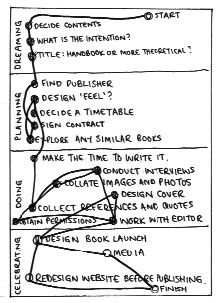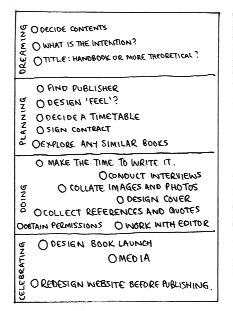6 Mar 2008
12 Tools for Transition No.4: The Board Game – a tool for identifying your vision and making it real
 The Board Game is a great tool for the identification and design of a project’s many stages, developed by John Croft of the Gaia Foundation of Western Australia. It also creates a checklist to which one can return as the project progresses, to get a sense of how it is progressing. At an early stage in the Transition Initiative, the initial group of people who are passionate about the process comes together.
The Board Game is a great tool for the identification and design of a project’s many stages, developed by John Croft of the Gaia Foundation of Western Australia. It also creates a checklist to which one can return as the project progresses, to get a sense of how it is progressing. At an early stage in the Transition Initiative, the initial group of people who are passionate about the process comes together.
The ideal suggested circle size is 6-8 people – with more than that, break into groups and put the objectives together at the end.
Step One: What Do We Want To Achieve?
Each person is asked the following question in turn: “What would this project need to achieve to make your participation 100% worthwhile?” Croft suggests using a talking-stick or similar, so that people are listened to, and then to keep going round the circle until everyone has their full set of objectives listed. When you are satisfied you pass – and it may take three or four rounds until everyone passes. There is no evaluation, competition or criticism at this stage – just go on including all the objectives. When you have finished you have a list of objectives for the project, and the aim of the Board Game is to design a way to complete 100% of them.
Step Two: Creating the Board Game No. 1
 On a flip-chart-sized piece of paper draw a circle at the top labelled “Start” (where you are now and what the project is) and one at the bottom labelled “Finish” (where you want to get to and what, for the group, will constitute success). A project can be planned and created up to the point of its official launch, or to the point when the last champagne cork has been popped and the last penny spent and there is nothing more to do.
On a flip-chart-sized piece of paper draw a circle at the top labelled “Start” (where you are now and what the project is) and one at the bottom labelled “Finish” (where you want to get to and what, for the group, will constitute success). A project can be planned and created up to the point of its official launch, or to the point when the last champagne cork has been popped and the last penny spent and there is nothing more to do.
It depends on the project and on your aims (each phase can also have its own board game). Now invite the group to brainstorm the steps and tasks that will be needed to complete the project’s objectives. Central to Croft’s model is that any project has four key stages, dreaming, planning, doing and celebrating. Divide your sheet into these four sections and as the ideas start to flow from your brainstorming, place them in whichever of the four sections is most appropriate. Croft suggests that for those less experienced with this process you start by making a list of all the tasks and then labelling them 1 / 2 / 3 / 4 (or more than that if people see more than one) for each of the four stages.
When you have your list of tasks you can get a sense of the strengths and weaknesses of the group and of the project, whether you have mainly planners, dreamers, doers, or celebrators. Then give each element a circle.
Step Three: Creating the Board Game No. 2
Now add lines to start joining up your tasks. Where do you start, and what logically follows on from that? Every task should have at least one input and output – if you can’t find a way to connect tasks, then there is a step in the process that
is missing which you have forgotten about or not thought of, so where appropriate add them in.
Step Four: Using Your Board Game
When everything is connected up you have the plan for your project. Then ask each person in the group to identify:
which task/s they feel passionately about – add their initials in one colour
• which tasks make them feel scared witless, or really afraid of taking on – add initials in 2nd colour
• which tasks they feel competent to do – add initials in 3rd colour.
These are the people who should do the tasks. People taking on fearful tasks will need support –someone who knows what they’re doing. Tasks with lots of inputs and outputs are key, and you need to make sure they are resourced properly.
 Step Five: Your Board Game as an Ongoing Tool
Step Five: Your Board Game as an Ongoing Tool
As soon as you have completed your Board Game, go through the Board to see where your project is at the moment (i.e. some of it will have already started). Then:
- cross-hatch the circle of any task you have started
- fully colour in the circle of any task you have completed.
This Board Game is the agenda for every ensuing meeting, and an ongoing record of what’s happening. Keep hatching and colouring in as your project progresses, and make sure to celebrate each time you do that. If an individual task is complex it may require its own Board Game – with the understanding again that within each task are the four steps of the process.
This exercise was written up by Naresh Giangrande of Transition Training. All 12 of these Tools for Transition can be found in The Transition Handbook, available here.
Where next for Transition Town Westcliff? « Transition Town Westcliff’s Weblog
27 Sep 10:51am
[…] a short break for refreshments, Kamil introduced the ‘Board Game’ method of particpatory consultation, going around the room and asking each person in turn “What […]